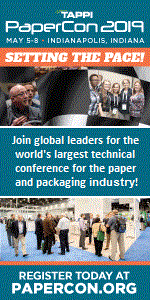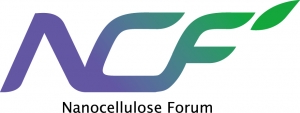| |
 · www.tappi.org
· www.tappi.org
· Subscribe
to Ahead of the Curve
· Newsletters
· Ahead
of the Curve archived issues
· Contact
the Editor

|
|
|
|
Unlocking Product Potential with Renewable Nanomaterials
JANET LOBUE, JAN BOTTIGLIERI
The following is an excerpt from an article that first appeared in the March/April issue of Paper360° and is offered here for Ahead of the Curve readers who may have missed it.

The growth of nanomaterials research has accelerated rapidly over the past 10 years. According to industry organization StatNano, in 2018 a total of 13,046 published patent applications related to nanotechnology were filed at the United States Patent and Trademark Office and the European Patent Office.
Yet nanotechnology research and development as it specifically pertains to renewable materials (e,g., nanocellulose, nano lignin, nano hemicellulose, etc.) is a much smaller and less funded subset of the world's research into nanotechnology, according to TAPPI's Nanotechnology Division Chair Robert J. Moon, Ph.D., materials research engineer with the USDA Forest Products Lab.
Growing interest in green chemistries is helping to change that, and cellulose—the most abundant organic compound on Earth—will be key. "Indeed, materials from bio-based resources have attracted immense research interest in recent years as a result of their very high potentials for fabricating several high-value products with low impact on the environment," writes researcher Djalal Trache of Ecole Militaire Polytechnique, Algeria.1 "Effective utilization of various nature-based nanomaterials offers certain ecological advantages—extraordinary physicochemical properties and high performance, to name a few. However, full employment of the intrinsic properties of starting nanoscale materials necessitates continuous development of robust and versatile isolation, synthetic and processing procedures to well control assembly over a variety of length scales."
.png)
Another important shift in the nanocellulose research field has been away from characterizing the properties of nanocellulosic materials and towards commercialization, according to researcher Araceli García, Laboratoire de Génie des Procédés Papetiers.2 "Today the major part of the published documents are related to the application of these nanostructures in nanocomposites (morphology, mechanical/thermal behavior), papers (coating, bulk addition), in various aqueous-based formulations (rheology modifier, food, cosmetics) or even in medical applications (scaffold, drug release)," he writes. "This difference shows a drastic change in the nanocellulose research field, and indicates a clear shift towards the industrialization and the development of new cellulose bio-based products."
Japan and China Move into Major Nano Research Roles
Which countries play a major role in this research? According to StatNano, the United States, and countries from East Asia including Japan and China, held the lion's share of total applications.
Japan's government has been significantly investing in nanotechnology since 2001 when it introduced its second Science and Technology Basic Plan (STBP), covering the years 2001-2005. In its second iteration, the plan prioritized nanotechnology and nanomaterials as one of eight national issues of interest. In the plan's third update, covering 2006-2010, nanotechnology rose to one of four "priority research" fields. In Japan's fourth version of the STBP, nanotechnology is considered the "foundational pathway" toward the development of the green and life innovations that are the plan's main focus.
Similarly, the Chinese government has invested heavily in nanotechnology research through its National 863 Hi-Tech R&D Plan, which funded both central and local government projects. In 2001, the Shanghai Nanotech Promotion Center (SNPC) was launched as a hub for R&D. The growth of R&D in China has been exponential, with roughly 90 percent of the country's nanotechnology R&D taking place in major economic centers like Beijing, Shenyang, Hangzhou, and Hong Kong.
In light of Asia's status as a nexus of nanotechnology R&D, the TAPPI 2019 International Conference on Nanotechnology for Renewable Materials (TAPPI Nano) is being held in Chiba, Japan. The theme of the conference is Unlocking Product Potential with Renewable Nanomaterials. TAPPI Nano will take place June 3-7 at the Makuhari Messe International Convention Complex (visit www.conference.tappinano.org for details.)
For the first time, TAPPI Nano will co-locate with the Nanocellulose Forum (NCF). NCF was established in 2014 by the Japanese Ministry of Economy, Trade and Industry (METI) and the National Institute of Advanced Industrial Science and Technology (AIST) to accelerate nanocellulose-related business throughout Japan. It includes representation from 223 different industries, 86 researchers, 6 ministries, and 47 local Japanese governments, and covers the entire nano supply chain—from fabricators and users to manufacturers.
According to Moon, conference submissions reflect each country's respective intense focus on nanotechnology R&D. "We received a record-breaking 300-plus abstracts this year, with China submitting 89 and Japan 56," says Moon. He notes that Europe—with a concentration from Scandinavian countries, primarily Finland—submitted 60 research abstracts, while the United States offered 31 submissions.
This year will have a higher focus on technical advancements in production and use of renewable nanomaterials, including those in industrial or pilot scale production or industrial applications and end uses. The Conference Committee's reasoning, says Moon, is to ensure a variety of technical topics that encompass areas beyond paper and packaging applications—including automotive and other manufacturing processes, additive manufacturing, and lignin and hemicellulose nanomaterials.
Attendees at TAPPI Nano will have access to the Nanocellulose Exhibition featuring some of the newest technologies and developments from leaders in nanocellulose research and development. Exhibit highlights will include mass production, application research, end-products, production machinery, and analytical instruments.
Japan: An Epicenter of Nanocellulose Engagement
"There is a growing global momentum in nanocellulose research and development, with pilot scale production in Japan and elsewhere moving rapidly toward commercial scale quantities," remarks Moon. "The technology is now out of the lab and moving into a much grander scale. It's exciting to see the range of new materials being developed and Japan is certainly one of the countries leading the way."
Japan's high level of engagement in research and the transition to production was one of the primary reasons that it was selected as the location for the 2019 conference. According to Conference Co-Chair Alan Rudie, Ph.D., assistant director, USDA Forest Products Laboratory, Japan is a leader in taking nanomaterials from laboratory to production. "They are using nanocellulose in a variety of products right now, including shoes, pens, composites for electronic circuit boards, food additives, and automobiles, to name just a few."
In Japan, scientists and academics from a number of universities are also heavily invested in nanotechnology research, including the University of Tokyo and Kyoto University, where work is ongoing in the area of plastic/CNF composites for automobiles. Experts expect that, ultimately, Japan will be using nanocellulose materials to mass build and produce carbon neutral automotive parts, bio-based fibers, gas-barrier packing films, electronic devices, high performance separators, catalyst supports, housing materials, insulators, cosmetics, and capacitor/separators for batteries.
"That's what is so exciting about the 2019 Conference," says Moon. "We're taking theory and showing its real-world application in a wide variety of industries. We're not pigeon-holed into one area; instead we're providing equal value to presenters and attendees. Representatives from these different industries tell us the problems they are encountering, while the researchers gain insight into where and how their work should progress in order to address these issues."
To learn more about the 2019 International Conference on Nanotechnology for Renewable Materials, and for program updates as they develop, visit www.conference.tappinano.org.
REFERENCES:
1. Trache, D., Hussin, M. H., Haafiz, M. M., & Thakur, V. K. (2017). Recent progress in cellulose nanocrystals: sources and production. Nanoscale, 9(5), 1763-1786.
2. García, A., Gandini, A., Labidi, J., Belgacem, N., & Bras, J. (2016). Industrial and crop wastes: A new source for nanocellulose biorefinery. Industrial Crops and Products, 93, 26-38.
About the author:
Janet LoBue is marketing manager for TAPPI. Reach her at jlobue@tappi.org or 770.209.7256. Jan Bottiglieri is editorial director for Paper360°.
For a modest investment of $174, receive more than US$ 1000 in benefits in return.
Visit www.tappi.org/join for more details. |
|





.png)